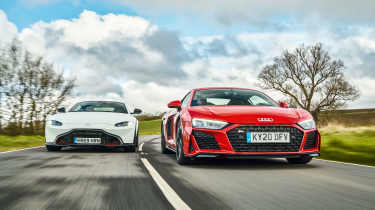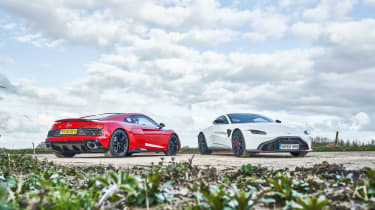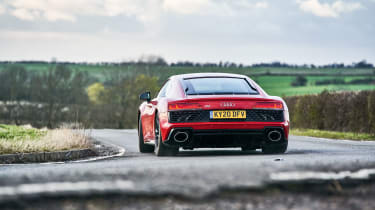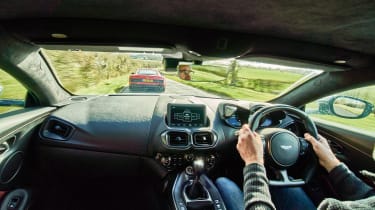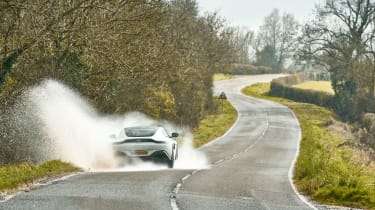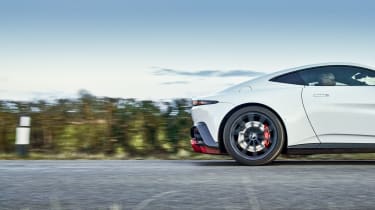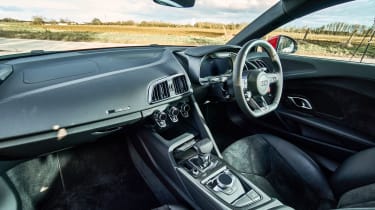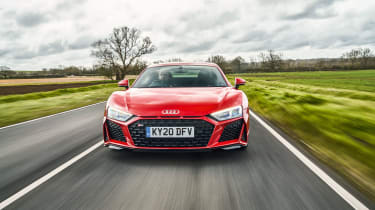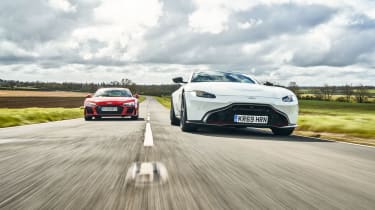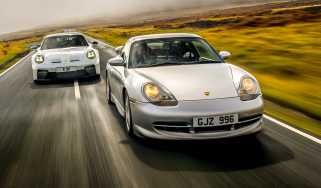Aston Martin Vantage vs Audi R8 V10 RWD – back to basics
Can forgoing performance-enhancing technology such as an auto gearbox or four-wheel drive make for a more engaging car? The new manual Aston Martin Vantage and rear-drive Audi R8 hold the answer
Sometimes I wonder whether I only imagined that in the early 2000s Porsche GB sent evo a basic 911 for a few weeks. I like to think that it was because they never had any bookings on it, everyone wanting the faster, sportier models. It was completely standard, toting the smallest engine and the manual gearbox, the smallest wheels and tallest tyres, and the discreet, standard exhaust. It was white, so even the paint was bog-standard. And it was wonderful: tactile and characterful and easy to get along with, with a lovely gearshift and comfortable ride, but superb when pushed too, its dynamics engaging and adjustable. It was also fast, the delivery of its guttural flat-six ramping up to a thrilling climax.
Given that this was the time of the C4S, the GT3 and GT3 RS, the Turbo and GT2, I and a few others were surprised and delighted to find that this bum-basic 911 was all the 911 you’d ever need. It wasn’t that the more potent 911s necessarily conformed to the law of diminishing returns – they were complete cars, whole different characters – but that the entry- level 911 showed that it wasn’t all about speed, about getting there as fast as possible. It was about enjoying the process of driving, savouring the journey.
There can be no other explanation for Aston Martin fitting a manual gearbox to the Vantage. The seven-speed Graziano manual ’box is 60kg lighter than the eight-speed ZF automatic, but that is of little consequence; it doesn’t drop the 0-62mph time because there’s a lot more work for the driver to do, to make the perfect launch and then nail the first-to- second shift that is unhelpfully a dog-leg. Aston’s own figures suggest a deficit of almost half a second compared to the auto – 4.0sec versus 3.6sec. The upsides? It may give a fractional improvement in in-gear response, but the primary reason for hooking up the 503bhp Mercedes biturbo V8 to a manual gearbox is driver engagement and involvement.
> McLaren 600LT Spider v Aston Martin DBS Superleggera Volante – open conflict
The same is true of Audi’s decision to follow up its recent limited-edition R8 RWS (for Rear Wheel Series), with a regular production version, the more accurately titled R8 V10 RWD. This too comes with a weight saving of around 60kg, which, again, does not translate into a reduced 0-62mph time. In this instance it’s because the deleted parts that save this weight – the centre diff, driveshafts and front diff – are the parts that help the all-wheel-drive R8 put down all of its power off the line. Again, what we’re being sold is a car that’s not faster or more capable, but one that’s more engaging and rewarding.
In this instance it’s because the deleted parts that save this weight – the centre diff, driveshafts and front diff – are the parts that help the all-wheel-drive R8 put down all of its power off the line. Again, what we’re being sold is a car that’s not faster or more capable, but one that’s more engaging and rewarding.
Is this an emerging trend? We hope so. As explained in our feature ‘The evo Blueprint’ in issue 270, cars are now so potent, so grippy and so fast they’re difficult to exploit on the roads we love – winding A-roads and dramatic B-roads. So it’s interesting to see cars aimed at increasing the level of interaction.
In the past few weeks, Honda announced a couple of new Civic Type R variants, one of which was a 100-unit, lightened quasi-racer, the other, intriguingly, a less hardcore Sportline model. It has 19 instead of 20-inch wheels that are shod with deeper sidewalled, more supple tyres, plus improved sound deadening and a more subtle rear wing. It’s still a wild- looking car but should be even better suited to our roads. There is a precedent for this approach, of course, in the form of cars such as the 911 GT3 Touring.
Aston’s decision to fit a manual gearbox to the Vantage is more interesting. The popularity of the manual ’box for sports, GT and supercars in particular has been in decline for many years now, for some good reasons. Manual gearboxes capable of handling large amounts of torque often have a heavy and unwieldy shift action and come with a thigh-pumping clutch. What has also hastened the manual’s demise is the roll-out of the dual-clutch transmission (DCT), which offers the ease of use of a traditional auto with the direct throttle-to-driven- wheels connection of the manual.
I confess that I lied earlier when I said that there was no reason for Aston fitting a manual gearbox other than driver engagement. The US market, which, as you’d expect, buys relatively few manual gearbox cars, also demands them for nebulous reasons of credibility; ergo a proper sporting car needs to have a manual option. This explains why BMW’s V10- engined E60 M5 was offered only in the US with a six-speed manual. By all accounts it wasn’t a great ’box, but for those of us here in Europe who loathed the clunky, desperately
unintuitive seven-speed SMG III automated manual, it might still have made the V10 M5 more appealing.
It also explains why Jaguar went to the trouble of creating a manual F-type. It wasn’t a popular option, partly because it wasn’t a very sporty shift. I was involved in its development when I worked at JLR, having in mind some great shifters for target setting, including the light, swift and tactile six- speeder in the 997-generation 911. So I knew that despite working with the various teams and improving and refining what we’d started out with, in the end it was only OK. The effort-to-reward ratio wasn’t sufficiently positive.
The experience gave me a vivid appreciation of just how many tunables or variables there are in a ‘simple’ manual shift. Refining the behaviour of a DCT through its mapping is an art, but this seems simple compared with finessing a manual shift. From the top, there’s the shape and mass of the gearknob, the length and throw of the lever, the friction in the shifter rails, the strength of the detent action that tells you the gear has gone home, the strength of the cross-gate springing and even the tension in the gaiter. Then there’s the geometry of the driving position, the leverage you can muster (especially for reverse, which might be awkward and require a higher effort), the amount of elbow room the centre console and seat bolsters allow, the space for the third pedal and its relation to the others pedals, the travel of said pedal, its weighting and the positivity and position of the clutch bite point. And all of this has to work harmoniously in both lazy shifting and all-out performance testing.
So I come to the Aston with an appreciation of the challenges. I’ve also spent a couple of days in editor Stuart Gallagher’s auto Vantage long-termer and enjoyed it, though the sharp throttle that can make manoeuvring alarmingly abrupt, especially when combined with the cold-start high idle, demonstrated that it’s not a transmission that doesn’t sometimes require finessing by the driver.
First impressions of the manual? Boy, they don’t make liking this car easy. Given that it has a thundering, torque- rich V8, why does it need seven gears? And why is the gate ‘upside down’, with the odd gears – 1-3-5-7 – at the bottom (unlike Porsche’s seven-speed manual, which takes a regular double-H configuration and then adds seventh gear top- right)? Go to engage first out on the dog-leg and, oh dear, it feels like you’re articulating a leg attached to a chicken carcass. And the clutch seems short-travelled. First is a long gear too, so you will need to use it.
More positively, initially the gear indicator in the instrument pack is very useful and away from first the throw and efforts are good. What’s really unexpected, though, is that within a few miles I’m really enjoying it, and for the reason you expect: control – though control of pace rather than of power arriving at the rear wheels. I’d probably be travelling quicker in the auto, but the manual adds punctuation to your progress and makes you consider how you’re using the engine. The V8 is so torque-rich that it will haul healthily from tickover off boost and you can then feel the surge when the turbos kick in at around 2000rpm. Using more of the engine’s bandwidth reveals more of its character and makes the experience richer and more nuanced.
Once you recognise that the cross-gate springing centres the lever in the 4/5 plane at rest, you can navigate the 2-7 part of the gate with some finesse. In fact, I was enjoying using it so much that it was some time before I noticed that rev-matching was turned on. The ZF auto feels pretty direct, but the fidelity of throttle response in the manual is sublime and it matches the direct, feelsome steering and dynamics that, after some low-speed toughness, have a relaxed tautness and precision. I’m not sure that the direct throttle connection makes balancing the Vantage in a slide much easier, mainly because the engine’s turbos spool up once the rear tyres start overspeeding. It’s a far from perfect shift, as revealed when you have to make a hurried downshift and get lost in the gate, but it’s properly engaging.
Being just rear drive, the Audi is more fundamentally altered. Yet if you didn’t know, you probably wouldn’t guess either from its appearance (there is no badging, only body-coloured lower side blades) or from how it drives, because most of the time it feels just like the regular all-wheel-drive V10.
I was lucky enough to drive a rear-drive R8 way back in 2011, in Germany, and it was exciting and pretty exhausting. It came with a ten-position traction control system that I had dialled almost back to zero by my fourth stint, but you can do that on warm slicks, with downforce and inspired by the prospect of a top 20 finish at the Nürburgring 24 Hours…
The R8 LMS is cited as the inspiration for the road-going, rear-drive R8 and that’s fair enough. As a bonus, the 533bhp R8 RWD is also the entry-level model, costing £114k, about £14k less than the basic 562bhp all-wheel-drive model. As well as body-colour sides, the RWD comes with gloss black, 19-inch forged wheels that look quite small in the arches, while inside, the uniformly grey trim is neat if a little plain.
After the Aston with its shallow windows, high waistline and bombastic V8, the Audi feels low-slung yet wonderfully airy, and more sophisticated, its V10 firing up with a yowl like a pair of super-smooth Ur-Quattros. Pull the stumpy T-bar shifter into D, give the throttle a tickle and the R8 sets off effortlessly, its ride sensationally supple. This is not the edgy, race-inspired car you might have been expecting.
It’s almost all too easy, the dual-clutch, seven-speed S-tronic gearbox shuffling the gears seamlessly, and I can’t help being reminded of the original Honda NSX. However, it all changes the first time you pin the throttle to the carpet.
In an instant you’re caught in a hurricane of V10 fury, fired off down the road by a solid, neck-testing shove, the cockpit filled with the urgent, offbeat bark of ten cylinders keening to 8000rpm. This may be the tamest version of the V10, but it’s still the full 5.2 litres, well over 500bhp and it loves to rev. It’s every bit as punchy as the Aston, just in a different way.
It’s very different dynamically, too. Dropping drive to the front wheels has rebalanced the weight distribution so that it’s now 40:60 front to rear. You feel it too, especially at speed, the nose hanging for just a fraction when you want it to turn, the rear settling heavily into the direction change a moment later. There’s lots of grip so it’s not an issue, but the RWD lacks adaptive dampers and is not as resolutely controlled as it could be. I can’t help thinking that the sadly long-since dropped V8, which was better balanced, would have been a better candidate for rear drive.
The Audi has a limited-slip diff and, apparently, if you select Sport mode and ESC there’s a drift mode. Maybe if you’re on track it’s handy. On a wet (or indeed dry) road, a little tickle of oversteer is all you want, just to help define the limit. Both the R8 and Vantage give up their rear grip reluctantly, the Vantage the more easily provoked in the wet, a modicum of boost gently pushing the rear out, the R8 better in the dry, not straying too far out of line when grip is breached.
So, do they deliver on their promise, this pair? Do they increase your interaction and your satisfaction? I love lots about the R8 RWD. Trouble is, all of it applies equally to the four-wheel-drive version, a car that sends so little torque to its front axle that it feels rear drive most of the time and then exploits its four-wheel drive when there’s a performance advantage to be had, without you even noticing. The R8 RWD is a good car, it’s just that it offers no real advantage except cost. In this instance, less is less.
The manual-gearbox Vantage is more complicated. It has more gears than it needs and, overall, it’s not a great shift, the feel into first being particularly poor. The busy pattern and ease of wrong-slotting under pressure count against it too... and yet it reveals more of the Vantage’s character than the auto, good as it is, ever could. The way you can work the engine, the way you can set the pace, and the extra depth and nuance this brings to the Vantage experience is unexpectedly remarkable. There’s more for the driver to do, and if you’re up for the challenge, more is emphatically more.
This feature was first published in evo 273. To get the next issue delivered to your door before it hits the shops, subscribe here.

